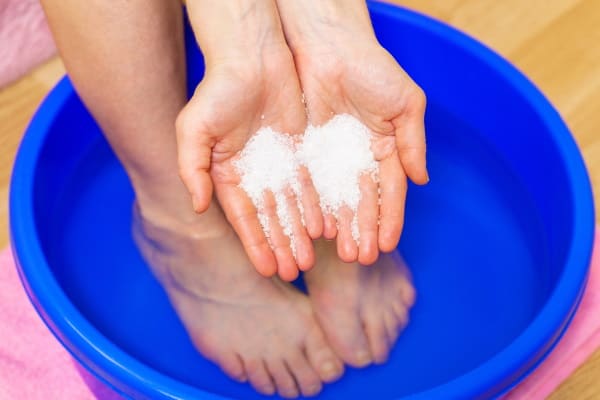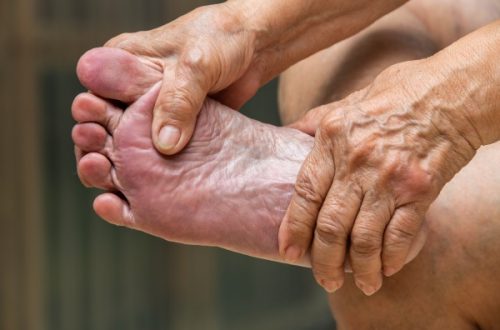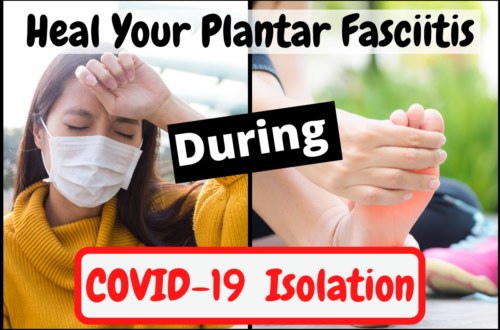Plantar fasciitis is a debilitating condition that generally takes some time to heal. There are a number of things that you can do at home to promote recovery and require no medical intervention.
So what are the remedy treatments that can help to heal plantar fasciitis at home? Plantar Faciitis is a condition that will generally heal itself over time, but it is a long and slow process. In rare instances medical intervention may be required, but in most cases, sufferers can help speed up the process of recovery themselves. Below are 17 home remedies that have been proven to help heal plantar fasciitis at home.
- Rest
- Stretching Exercises
- Massage Therapy
- Heat & Ice Therapy
- Preventing Re-Injury
- Foot Taping
- Orthotic Inserts
- Compression Socks
- Supportive Shoes
- Anti-Inflammatory Diet
- Night Splint
- CAM Walker Boot
- Weight Loss
- Holistic Therapy
- Low Impact Sport
- TENS Therapy
- NSAID’s
We will now look at each method in greater detail to see how they can benefit your plantar fasciitis recovery. Please take the time to read about each step as there is information within each method that may not be initially obvious, but is vital to speeding up your recovery.
Rest
The number one thing that will benefit your plantar fasciitis more than anything else is REST.
By taking the weight off your feet (literally), you will allow the bodys own natural healing process to take place, and it will begin to repair the damage to your plantar fascia.
The more time you can spend with your feet up, the more time your body will have to repair itself.
If, out of the 17 methods listed above, you only did this one thing, you would still be giving yourself a good chance of speeding up your recovery.
Stretching Exercises
By incorporating gentle stretching exercise into your daily routine, you are helping to strengthen the plantar fascia to support your body weight.
It cannot be stressed enough that this must be “gentle” stretching, as you do not want to overstretch the plantar fascia and cause further damage.
After resting, some of the damage to your plantar fascia will have repaired itself. By gently stretching the plantar fascia prior to standing and applying your weight, you will reduce the chances of re-injury. We will look in more depth at preventing re-injury later in the list.
You can see the types of stretching exercises you should be doing by looking at our post : 5 Minute Stretching Routine For Faster Recovery
Massage Therapy
By massaging the affected foot, you are helping to increase blood flow to the damaged area, which stimulates the natural healing process.
You can massage the foot in many ways, either on your own, with help from a partner, or even by using a massage ball or machine that are available on the internet such as these ones sold on Amazon (link)
Of course there are also household objects that can be used to roll your foot over that will massage and stimulate blood flow.
- Tennis Ball
- Golf Ball
- Rolling Pin
- Frozen Bottle of Water
Here is a video of a self foot massage technique:
Heat or Ice Therapy
Depending on how long you have suffered with plantar fasciitis, will determine whether you should apply heat or ice to the foot.
For Acute plantar fasciitis, you should apply ice therapy. Acute means that you have suffered with the foot pain for no more than 8 weeks and so the condition is in the early stages.
It is during the acute phase of the condition that your home remedies will be the most effective and recovery time should be fairly short due to the minimal damage to your plantar fascia,
If you have had the foot pain for longer than 2 months, then you will be suffering from Chronic plantar fasciitis and so ice therapy will be ineffective at this stage, unless you suffer a further fresh injury.
Chronic plantar fasciitis will benefit more from heat therapy, and will probably take longer to heal as the damage is likely to be greater.
You can find more information about heat and ice therapy, and how to apply it effectively, in our article : Is Heat or Ice Therapy Better For Plantar Fasciitis
Preventing Re-Injury
The most effective way for you to reduce your recovery time is to prevent re-injury from occurring. Sounds pretty obvious right?
Many people are not aware that they are responsible for the re-injury that occurs, and feel it is just a symptom of having plantar fasciitis.
If you have experienced that sharp pain in your foot when you have got out of bed in the morning, then you have probably been a victim of self caused re-injury.
During the night your body has been hard at work repairing those tiny tears that are causing the inflammation in your plantar fascia, and they have begun to close up and heal.
When you stand and apply your body weight to your foot, without first doing the gentle stretching that we mentioned earlier, you rip open those partially healed tears, and that is what causes the excruciating pain.
As you can see, this is why we say that you must make sure that you gently stretch the plantar fascia before standing and applying weight to your foot.
It is absolutely vital that you do not allow those partially healed tears to be opened up again, as it will just undo all the healing that has taken place through the night, and set your recovery back to the start.
You can read more about preventing re-injury in our article: For Faster Recovery You MUST do This!
Foot Taping The Plantar Fascia
Taping is an effective way to reduce the stress on the plantar fascia and allow healing to take place.
Just a few strips of KT Tape which can be applied within minutes, will provide relief and support to the plantar fascia.
Athletes and runners who are prone to plantar fascia related issues such as plantar fasciitis or a major plantar fascia tear, use the taping method to speed up recovery and allow them to get back into training.
The tape is available from Amazon (Link) and the video below shows just how easy it is to apply.
Orthotic Inserts
Orthotic inserts are products designed to help relieve the pressure and stress on the damaged part of the foot, thereby allowing the healing to take place.
There are many foot orthotics that are available over the counter from your local pharmacy or online stores that will help speed up your recovery. Some of the more common orthotics are:
- Arch Supports
- Heel Cups
- Heel Lifts
- Insoles
It is also possible to have custom made orthotics, however these can be very expensive and usually need to be made by a qualified podiatrist. It is probably wise to see how you get on with the over the counter options prior to spending money on custom fitted orthotics.
Also available on the market are semi-custom insoles that bridge the gap between over the counter and fully customised products.
With the self mold insoles, you just heat them in hot water, mold them to the shape of your foot and allow them to cool and harden. You then insert the pair of shoes you wish to wear and they fit snugly to your foot providing the required support. These are usually a bit more expensive, around $50 on Amazon (link), but a much cheaper option than the hundreds of dollars that full custom orthotics will cost. Also, they allow you to reheat and re-mold as and when required for a continued snug fit.
For more information on the different types of orthtics available and how they work, check out our article: Foot Orthotics for Plantar Fasciitis Explained
Compression Socks
Wearing compression socks is another way that you can help to heal your plantar fasciitis at home. Well, not just the home, but anywhere really, at work, on the bus, out shopping, pretty much wherever you go.
Compression socks can be worn at any time and help to reduce swelling in the foot. They also provide support to the foot and arch, as well as improving the blood flow to the affected area of the foot which encourages healing.
The fabric used in the compression socks is usually breathable to prevent sweating and odors, and is also woven in such a way as to provide support where it is needed, primarily in the arch of the foot and around the ankle to provide stability and support.
They can be worn under normal socks, and for any length of time, including in bed at night. This really is an effortless way to help with your home recovery.
We have reviewed 3 of the top selling compression socks here.
Wear Supportive Shoes
This really is a big one that you are strongly encouraged to follow.
Wearing strong supportive shoes is an absolute must if you wish to recover fully from your plantar fasciitis.
One of the main causes of plantar fasciitis is the wearing of non supportive footwear.
You may have spent a lot of money on your shoes, but if you have been wearing them for years and they are worn out, they are no longer providing the support needed and it is time to replace them.
Another common culprit is worn out running shoes.
Many runners are guilty of breaking in a pair of running shoes and then continuing to wear them well past their designated life span, just because they are still comfortable to wear.
Remember, your feet have to carry you all day long and every time your heel strikes the ground, the pressure it has to bear is over 2 times your weight. Even more when you are running.
As you can imagine, that constant pounding day after day, step after step is going to take its toll if your shoe is not offering the support and protection that it should be.
It’s not just worn out shoes that cause problems either. Here are some other types of footwear that offer little to no support and can contribute to getting plantar fasciitis:
- flip flops
- high heels
- sandals
- surf shoes
If you think that your current footwear is no longer providing the support your feet require, then it is time to get yourself down to the shoe shop and replace them.
Ideally you want to go to a shop that can measure your feet to ensure you get the correct size and fit. They may also be able to detect if you have high or fallen arches and offer appropriate shoes that offer the support required.
There is little sense trying to cure your plantar fasciitis if the shoes you are putting onto your feet are part of what is causing the condition in the first place.
Do yourself a favor, no matter how comfortable or attached you are to them, ditch and replace any old or worn out footwear!
Bonus Tip!
Check the soles of your worn shoes to see if there is an uneven amount of wear in certain areas. If your shoes are more worn on one side of the shoe than the other, you may be favoring a certain part of the foot and causing more stress on another part. This can also lead to plantar fasciitis or other foot problems.
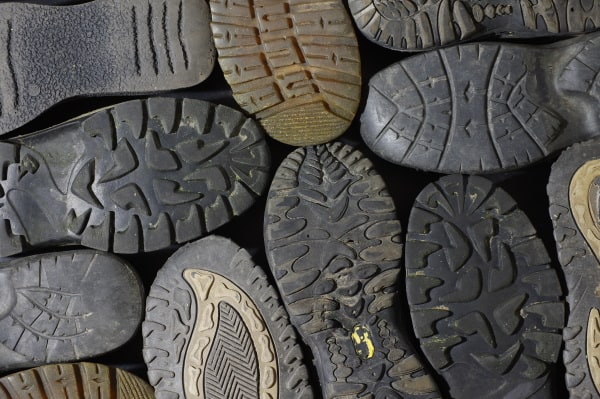
Try an Anti Inflammatory Diet
You may not be aware, but certain foods can have either a positive or negative effect on the inflammation within the body.
By increasing your intake of foods that naturally reduce inflammation within the body, you may find that your plantar fasciitis begins to calm down and reduce in pain.
Foods that can contain anti inflammatory proterties include:
- Fresh vegetables
- Fresh Fruit & Berries
- Oily Fish
- Nuts and Grains
- Certain Herbs & Spices
Just as there are foods that help with inflammation, there are also foods that can aggravate or irritate the inflammation.
The types of foods that you should try to avoid are found within the following:
- High Fat & Processed Meats
- Dairy Products
- Candy, Cakes & Snacks
- Breads & Pasta
- Alcoholic Drinks & Soda
For a more comprehensive list of the types of foods that you should increase or decrease within your diet can be found in our article: How Diet Can Affect Plantar Fasciitis Recovery
Wear A Night Splint / Sock
Another effortless way to help heal your plantar fasciitis at home is by wearing a night splint or splint sock.
These are odd looking contraptions, but work well and are inexpensive. They will help keep the plantar fascia stretched while you sleep and reduce the need to do the gentle morning stretching routine that we talked about earlier.
The splint / sock can take a few nights to get used to as it holds your foot in a continually stretched position so that the plantar fascia does not contract during the night.
It is the contracted plantar fascia being abruptly stretched when you apply your full weight onto your foot that causes the re-injury we mentioned.
If you think that you may refrain from dutifully doing the morning stretching routine, then a night splint/sock may very well be the answer. Amazon Link
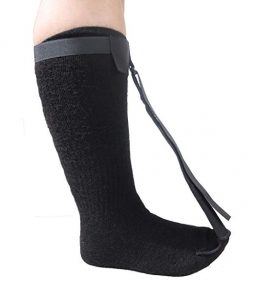
Wear a CAM Walker Boot
Another way of allowing the plantar fascia to heal is by wearing a Controlled Ankle Movement (CAM) boot.
A CAM boot is only really required in the more extreme cases of plantar fasciitis where the minute tears in the plantar fascia have developed into more major tears, and so the foot needs immobilising to prevent it getting worse or possibly rupturing completely.
The CAM boot is filled with air pockets that help to immobilise the foot. You can walk on the boot and it will help protect the plantar fascia from coming under stress when your weight is applied.
For more information about CAM boots, check out our article here.
Lose Weight
Easier said than done, but losing weight will have a dramatic impact on your recovery.
Obviously, the more weight you are carrying, the greater the stress on your plantar fascia to hold up the arches of your foot.
With the increase of weight, the plantar fascia becomes weakened and susceptible to injury.
This becomes a catch 22 situation as the weakened plantar fascia struggles further to carry the weight and so becomes further compromised until it can no longer carry the burden and becomes damaged.
A further complication is that most weight loss programs require some form of exercise. Any exercise that requires you impacting on your feet, such as running, will only further increase the chances of damaging the plantar fascia, or even rupturing it completely.
Losing weight will naturally lessen the burden on the plantar fascia and allow healing to begin, however caution should be taken to only partake in low impact exercise such as swimming until you are at a suitable weight, when more vigorous exercise can be accomodated without the risk of injury.
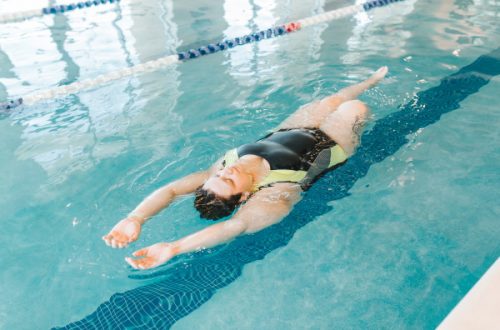
Hollistic Therapy
For many centuries prior to the modern medicines we have today, people were treated with natural remedies.
Such remedies are still in use today and many people believe that they offer better healing powers than the chemical induced medicines usually on offer.
As we have mentioned earlier, there are many foods that offer natural healing qualities that could help with your recovery, but there are also many plants, flowers and trees that also offer relief.
Some of these remedies can come in the form of oils to rub into the foot, mineral salts, or vinegars to soak your feet in.
Here are just a few of the natural products used to help promote healing.
- Lavender
- ginger
- apple cider vinegar
- Aloe Vera
- Peppermint
- Lemongrass
- Mineral Salts
Go to your local health food store or research hollistic remedies and perhaps try putting some of these natural products to use.
Low Impact Sport
We touched upon low impact sport when discussing being overweight. however, it is not only heavier people that should consider low impact sports.
If you are a runner or partake of high impact sports that involve lots of jumping, or adding high stress to your feet, then you really want to reduce or eliminate those sports in favor of lower impact sports until your plantar fasciitis is healed.
You are going to have a long slow recovery if you continue to place the plantar fascia under unnecessary strain through your chosen recreational activities.
As we mentioned in the very first point of this list, REST is the most essential element of how to heal plantar fasciitis at home..
Allow your body the time to heal by giving it every opportunity to repair itself.
Even when you ‘think’ you are getting better, avoid taking part in high impact sports until you have been symptom free for at least 8 weeks.
Trying to go back to your sporting activities too soon will only see you return back to the start of your recovery when re-injury occurs.
Once you have been symptom free for 8 weeks, slowly introduce yourself back into the sport. SLOWLY!!
Once fully repaired, the plantar fascia will still be weak and will need to be built up to strength again.
Allow yourself the time to get back up to full strength and you will dramatically reduce the risk of a relapse.
Remember: Slow and steady wins the race!
TENS Therapy
There is a medical procedure known as electrical dry needling that is now used to treat plantar fasciitis.
This procedure involves small needles being inserted into the foot and an electrical current run through the needles.
You can read more about the procedure here.
Now, there is a less drastic version of the therapy that can be performed in the comfort of your home that doesn’t rely on you becoming a pincushion.
Tens Therapy! [source]
For about $30 you can purchase a TENS unit that will allow you to place electrode pads to your foot and pass an electric current through the pads to stimulate the nervous system and prevent pain signals from reaching the brain. The stimulation also releases endorphins which is the bodys own natural pain relief.
Electric impulse therapy has been found to provide stimulation and pain relief in many areas of the body, in fact tens machines are commonly used to help with the pains of labor and childbirth.
If you find that your plantar fasciitis pain is too much to bear, then TENS therapy may provide enough relief for you to heal your plantar fasciitis at home through the other methods listed.
Check out the reviews on Amazon of people who have found relief using a TENS unit.

Well done, you have reached the final point and so must be truly committed to healing your plantar fasciitis.
About this final point!
We were unsure whether to include the last item, but have done so to provide a full account of what a person can do to heal plantar fasciitis at home.
This method is mentioned in almost every guide as way to deal with plantar fascitiis pain, and so we include it here but advise caution!
VERY IMPORTANT NOTE:
Always check with a pharmacist or medical practitioner prior to taking any new medication (even non prescription).
Some NSAIDs can cause stomach issues and other gastro type irritation or bleeding and can have a reaction with other medication.
Ensure you are safe to take the pills and stop if you develop any negative side effects.
NSAIDs
Taking over the counter Nonsteroidal Anti Inflammatory Drugs (NSAIDs) is an effective way to reduce pain and inflammation.
There are several well known brands available to purchase without prescription.
- Asprin
- Ibuprofen
- Ketoprofen
- Naproxen
All of these can provide pain relief, however you must ensure that you take only as directed and check that they can be taken with any other medication you may be taking, and that they will not affect any other medical condition that you may suffer from.

Conclusion
As you can see, there are many things that you can do to heal plantar fasciitis at home without the need of medical intervention.
Recovery will not be easy and it will take determination and dedication to follow through on the daily stretches, exercises, rest etc, but you will benefit in the end.
Visiting a podiatrist, medical practitioner or hospital can be a costly affair and so you owe it to yourself to try and recover from the condition through your own methods if possible.
As was mentioned at the start, most plantar fasciitis cases will heal within a 12 – 18 month period, even if the sufferer does little to help themselves.
But by taking steps to heal your plantar fasciitis, you will dramatically reduce that recovery time, and get you back on pain free feet much sooner.
However, if after trying to recover under your own methods for over 6 months, you have not seen any significant improvement, then you may well need to consult with a medical professional to see if there is a more serious underlying problem.
Good Luck on your journey to pain free feet 🙂
